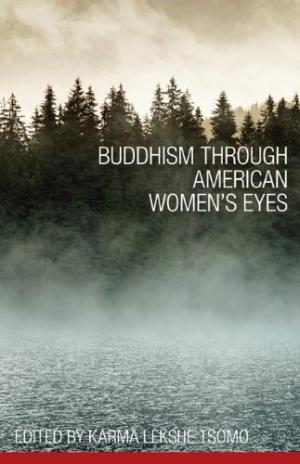Buddhism Through American Women’s Eyes

Buddhism Through American Women’s Eyes, a collection of thirteen essays edited by Karma Lekshe Tsomo, offers an introspective exploration of Buddhist philosophy and practices. First published in 1995 and re-issued in 2010, these works are written by women who attended a California retreat in August 1989.
The last chapter of the book, “Continuing the Conversation,” discusses the diverse experience of this retreat: “There was a mix of women, some of whom had been practicing for ten, twenty, or thirty years, and some who were brand-new to meditation, providing both depth and freshness, tradition, and innovation.”
This information could have been placed at the start rather than the end of the book to add context. For example, a few essays are interspersed with “Response” sections where the writer interacts with questions or comments from other participants. Without knowledge of the retreat, these sections may disorient readers.
There is some context—the introduction, “Openings,” addresses the patriarchy found within several Buddhist traditions, particularly how the texts teach enlightenment for all beings, yet give preference to men as the true spiritual conduits and teachers. One noted exception is the Vajrayana tradition of Buddhism with its female figure of enlightenment, Tara. Not surprisingly, this empowering representation doesn’t often extend to “actual living traditions in Buddhist society.” Buddhism Through American Women’s Eyes proves that women’s interpretations can transform Buddhist practice.
“Forging a Kind Heart in an Age of Alienation” and “Reflections on Impermanence” explore reconciliation and grief—subject matters for any practitioner. Yet these works also show that meditative practice can be imbued by women’s experiences. One writer narrates her difficult relationship with a terminally ill father and her decision to be open and honest with him instead of falling into the habit of “play[ing] the co-dependent role of ‘Mary Sunshine.’ ”
In “Mothering and Meditation,” Jacqueline Mandell shares how when her twins are born, a friend shows up for a week to help with housework and take care of the children. This prompts Mandell to consider the concept of “mother care.” Her Buddhist friends ask whether she has time to meditate, but she invites a better question: “‘Now that you’re a mother, may I help you so that you can meditate?’” “Abortion: A Respectful Meeting Ground” relates Yvonne Rand’s grief after having an abortion. Eventually, the Buddhist precept of not doing harm to living beings is what motivates her anti-abortion stance. However, Rand stays resolutely pro-choice. What seems like a contradiction is Buddhism in action—it is not about judgment. “There is no easy or ‘right’ answer,” Rand concludes. Instead, Buddhism is about “the practice of awareness.”
Other practitioners consider the intersection of Buddhism with relationships and daily stress. Many of the essays expand on karma as well as the conflict between Buddhist traditions and American life. A collaborative work, “The Monastic Experience,” personalizes this conflict as several women discuss their study and practice of Buddhism in the East and West.
Readers may want to know how or if the situation has changed for Buddhist American women since 1995, so an updated foreword could have proved useful. There is an excellent glossary and suggestions for further reading, yet the philosophical discourse is leveled at experienced readers of Buddhism. The book is accessible, but this is no primer.
Buddhism Through American Women’s Eyes is at its best when it leaves behind the abstract language of philosophy and connects spiritual practices to everyday concerns. For readers interested in Buddhist women, this book provides a voice for new traditions.